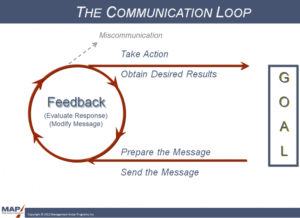Don’t Shoot the Messenger
One of the fastest ways to stifle communication is to penalize people for giving you bad news. Demonstrating this behavior on a consistent basis creates a covert culture in which issues can’t be discussed, much less debated. Worse, this practice can cause major problems for you when unresolved issues blow up in your face. Make a commitment to establish and foster a “safe” environment, where problems can be surfaced and solutions can be developed. When bad news comes, view it as an opportunity to fix the issue while supporting and improving your team.
Click here to download our free effective communication checklist.
To enable that safe environment for communication:Don’t attack. Get the facts and listen first to avoid jumping the gun, making assumptions, and voicing your feelings in a derogatory way. Focus on the problem, not the person.Never humiliate. Don’t indicate in any way that someone is being ignorant or short-sighted. Also, hold back from asking someone questions like, “Why are YOU bringing this to me?” Such variations of humiliation sever the spirit and can impact not just an individual’s self esteem but also a company’s entire morale. Communicate with the intention of helping, not hurting, always asking yourself before speaking, “Is what I’m saying going to improve the situation?” If it doesn’t, keep quiet.
Drop any defensives. When you get bad news, it’s not unusual to feel like you need to stick up for yourself by immediately defending your position, behavior or role in the situation. But this uncovers vulnerability and erodes leadership credibility by revealing just how easy it is to push your buttons. If you’re feeling the urge to defend yourself, take a short break from the situation and carefully formulate your perspectives and even try to detach from what is being said. Focus on an action plan that gets the situation moving toward a solution.
Ax your anger. Slamming your hand on the desk. Slamming doors. Slamming people with a raised voice. All of these are signs of anger management problems that need to be addressed. It doesn’t mean you can’t feel angry, but telling people you’re furious and behaving in an angry way are two different things. Expressing that you’re angry in a direct, yet professional demeanor allows people to know just how serious a subject is to you. Meanwhile, behaving angrily is a control tactic that frightens people into submission. Feeling angry can be constructive while being outwardly angry can be destructive. Know the difference and use your anger wisely.
Avoid the blame game. When someone brings you a problem and you turn it around and start to blame that individual, it shows you’re unwilling to own the problem. Maybe it’s not your fault, but blaming others blocks productive problem solving. Again, concentrate on what’s to blame not who to blame — don’t make it personal.
Check your body language. Even though you may have an open door policy, where people are free to come and talk to you, are you really giving them your full attention? Or are you rolling your eyes, crossing your arms, tapping your feet impatiently, or exemplifying other types of body language that contradict your intentions? Remember, how you express yourself through body language is just as important as any words you say.
What are some signs that a team has become afraid to share bad news with its leader?



